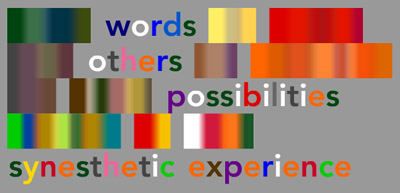|
For as long as I can remember, I've had this implicit sense of a relationship between letters and colors. To me, every letter seems to have a color of its own. When I think of a word, I am aware of its color and the color of its component letters. The phenomenon is consistent enough that I can rely on it to help me remember things like phone numbers and proper names. I call it my letter-color synaesthesia. Webster's Dictionary defines synaesthesia as "the production of a mental sense-impression relating to one sense by the stimulation of another sense." In my case, the sense-impression (color) comes from a purely mental event (thinking of a word), not from any external sensory stimulation. The effect is completely involuntary. It's a bit like what happens when you think of a word like "banana": maybe you see the spelling in front of your mind's eye, or maybe you hear the way it sounds in your mind's ear. But it's pretty likely that you are also at least faintly aware of the color yellow. That's pretty much what it's like: a faint awareness that can be brought to my full attention under certain circumstances. Here's an approximation of the basic mapping of the letters and numerals, taken individually, to colors:

Here they are again, over a dark background:
This may seem odd, but it gets stranger. What you see above are the colors of the letters taken in isolation. But when placed in the context of a word, a letter's color can change quite dramatically. First of all, vowels almost always fade into the background in the presence of consonants. They also tend to pick up some of the color of letters nearby. For example, the "A" in my name is overwhelmed by the strong green of the letters around it:
In longer words, the repetition of a single letter can even influence the other consonants, as in this case:
However, this is less often the case in a word that begins with a vowel. The letter "I" can give an entire word a luminescent quality, and the consonants often lose some of their power in its presence:
The color effect has very little to do with the pronunciation of a word. It has everything to do with the spelling. The first letter in particular has enormous influence:
The meaning of a word also has an undeniable influence on its color. For example, the word "banana" is as yellow for me as I imagine it is for anyone else, despite the fact that its letters are predominantly red. This fact was brought to my attention most recently when I encountered a new word:
Later, when I learned what the word meant, its color changed accordingly. Phthalocyanine turns out to be the name of a vivid blue-green pigment used in paint. Now the word looks something like this:
As I mentioned, I sometimes use my synaesthesia to help me remember difficult proper names. Here's a Thai chef who wrote a terrific vegetarian cookbook:
Unfortunately, this method can backfire too, because I confuse similarly-colored names easily:
This is especially problematic at parties.
|
jump to: interactive synesthesia demo synesthesia blog posts faq



